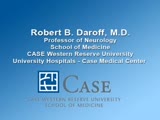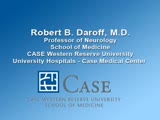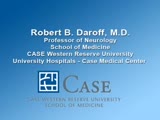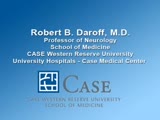The Robert B. Daroff Neuro-Ophthalmology Collection: Features a series of instructional video on eye movement disorders prepared in 1991. The original recordings were on 16mm film, mostly filmed in the 1960s and 70s in Dr. Daroff's laboratory at the University of Miami.
Robert B. Daroff, Professor and Chair Emeritus, School of Medicine, CASE Western Reserve University, University Hospitals - Case Medical Center.
NOVEL: https://novel.utah.edu/
TO
Filters: Collection: ehsl_novel_rbd
| Identifier | Title | Description | Subject | ||
|---|---|---|---|---|---|
| 51 |
 |
Daroff_Tape-1 | Cerebral Control of Eye Movements | In this series, the purpose and nomenclature of eye movements are described, with the anatomical pathways generating and controlling the cortically-driven movements -- saccades and smooth pursuit in horizontal gaze, upgaze and downgaze -- discussed in detail. The importance of each of the three sac... | Cerebellar; Eye Movement Disorders; Supranuclear Input; Optokinetic Nystagmus |
| 52 |
 |
Daroff_Tape-2 | Brain Stem Eye Movement Syndromes | In this series, the importance of the brainstem in eye movements is discussed, with particular emphasis is placed on the signficance of the paramedian pontine reticular formation (PPRF), the medial longitudinal fasciculus (MLF), and the nuclei and projections of cranial nerves III and VI. Correlat... | Brain Stem; Eye Movement Disorders |
| 53 |
 |
Daroff_Tape-3 | Cerebellar Eye Signs | Lesions of the cerebellum can result in a variety of eye movement disorders, including saccadic intrusions and oscillations, such as ocular dysmetria, as well as nystagmus, gaze palsies, and dysfunction of the vestibular ocular reflex. In this series of videos, these disorders are discussed in rela... | Cerebellar; Eye Movement Disorders; Cerebellar Pathology |
| 54 |
 |
Daroff_Tape-4 | Miscellaneous Ocular Oscillations | In this final series, several eye movement abnormalities are detailed with patients used to illustrate each. KEY WORDS: opsoclonus-myoclonus, opsoclonus, square wave jerks, macro square wave jerks, pause cell dysfunction, voluntary nystagmus, eyelid nystagmus, see-saw nystagmus, superior oblique my... | Ocular Motility Disorders; Eye Movement Disorders |
